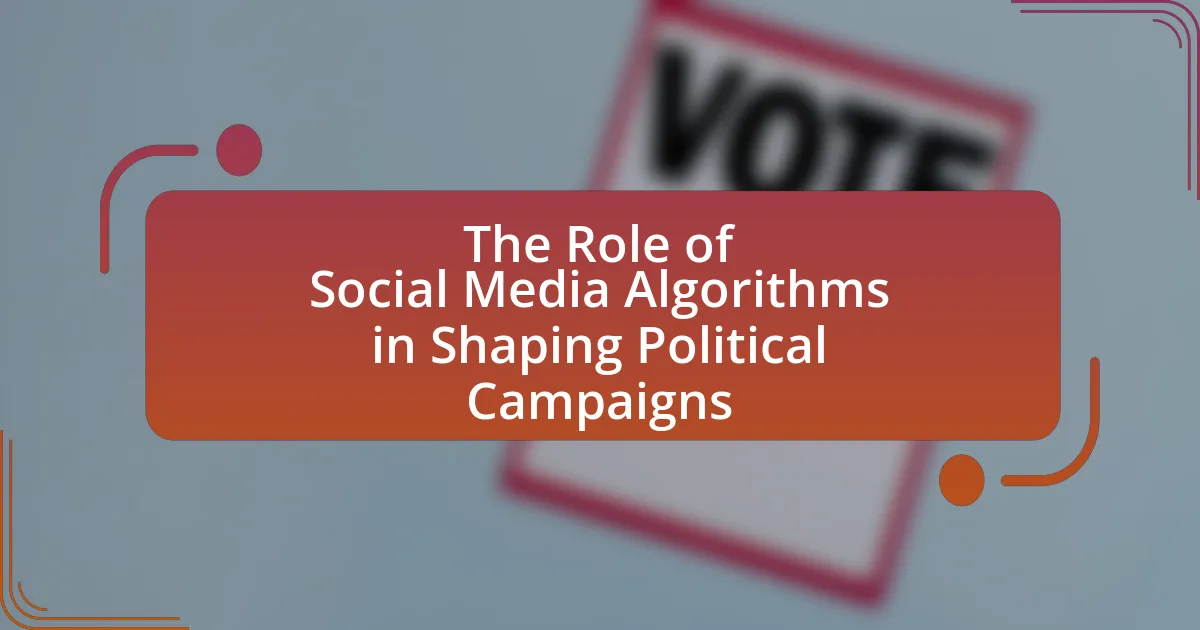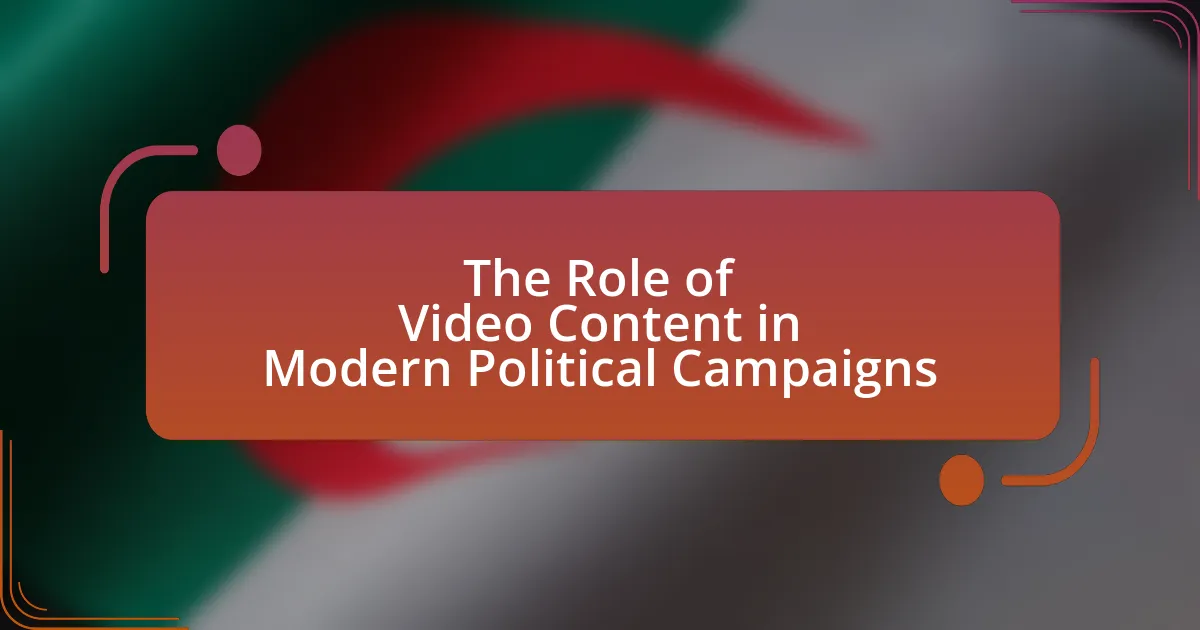The article focuses on successful digital campaigns in recent elections, highlighting the strategic use of online platforms and digital tools to engage voters and mobilize support. It examines the evolution of digital campaigning, emphasizing advancements in data analytics, social media, and targeted advertising that have transformed political communication. Key case studies, including the 2020 U.S. presidential election and the 2021 Canadian Federal Election, illustrate effective strategies and the importance of engaging younger voters through tailored content. Additionally, the article addresses challenges faced by digital campaigns, such as misinformation and data privacy concerns, while outlining best practices and future trends in digital campaigning.
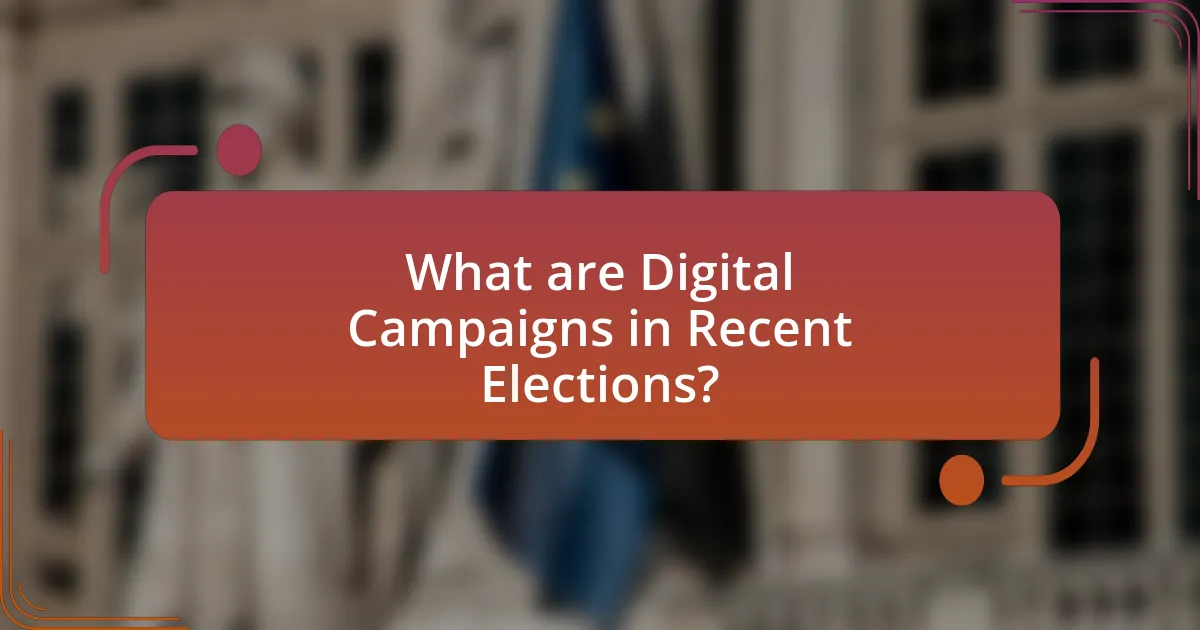
What are Digital Campaigns in Recent Elections?
Digital campaigns in recent elections refer to the strategic use of online platforms and digital tools to engage voters, disseminate information, and mobilize support for candidates or political parties. These campaigns leverage social media, email marketing, targeted advertising, and data analytics to reach specific demographics effectively. For instance, the 2020 U.S. presidential election saw significant digital campaign efforts, with candidates like Joe Biden utilizing platforms like Facebook and Instagram to connect with younger voters, resulting in a reported 50% increase in voter turnout among this demographic compared to previous elections.
How have digital campaigns evolved in recent elections?
Digital campaigns have evolved in recent elections by increasingly leveraging data analytics, social media platforms, and targeted advertising strategies. In the 2020 U.S. presidential election, for instance, campaigns utilized sophisticated algorithms to analyze voter behavior and preferences, allowing for personalized messaging that significantly increased engagement. According to a report by the Pew Research Center, 69% of Americans used social media to get news about the election, highlighting the shift towards digital platforms as primary sources of information. Furthermore, the use of micro-targeting enabled campaigns to reach specific demographics with tailored content, enhancing the effectiveness of outreach efforts. This evolution reflects a broader trend where digital strategies are integral to campaign success, as evidenced by the substantial investments in digital advertising, which reached over $1 billion in the 2020 election cycle.
What technological advancements have influenced digital campaigning?
Technological advancements that have influenced digital campaigning include social media platforms, data analytics, and mobile technology. Social media platforms like Facebook and Twitter have transformed how campaigns engage with voters, allowing for targeted messaging and real-time interaction. Data analytics enables campaigns to analyze voter behavior and preferences, facilitating personalized outreach and more effective resource allocation. Mobile technology has increased accessibility, allowing campaigns to reach voters through apps and SMS, enhancing engagement and participation. These advancements have collectively reshaped the landscape of political communication and voter mobilization.
How do digital campaigns differ from traditional campaigning methods?
Digital campaigns differ from traditional campaigning methods primarily in their use of technology and data analytics to target audiences. Digital campaigns leverage social media, email, and online advertising to reach specific demographics, allowing for real-time engagement and feedback, whereas traditional methods like print, radio, and television rely on broader, less targeted outreach. For instance, a study by the Pew Research Center in 2021 found that 69% of adults in the U.S. use social media, highlighting the potential reach of digital platforms compared to traditional media. Additionally, digital campaigns can track user interactions and adjust strategies instantly, while traditional campaigns often require longer lead times for changes.
Why are digital campaigns important in modern elections?
Digital campaigns are crucial in modern elections because they enable candidates to reach a broader audience quickly and efficiently. With over 4.9 billion internet users globally, digital platforms allow for targeted messaging that can engage specific demographics, increasing voter awareness and participation. For instance, the 2020 U.S. presidential election saw candidates utilizing social media to mobilize voters, with Joe Biden’s campaign reportedly spending over $100 million on digital ads, significantly impacting voter turnout. This demonstrates that digital campaigns not only enhance communication but also play a vital role in shaping electoral outcomes.
What role do social media platforms play in digital campaigns?
Social media platforms serve as critical tools in digital campaigns by facilitating direct engagement between candidates and voters. These platforms enable campaigns to disseminate information rapidly, target specific demographics through tailored advertisements, and foster community discussions around political issues. For instance, during the 2020 U.S. presidential election, over 70% of voters reported using social media to follow candidates, highlighting its influence on voter awareness and mobilization. Additionally, campaigns utilized social media analytics to refine their strategies, ensuring messages resonated with their audience, which contributed to increased voter turnout.
How do digital campaigns engage younger voters?
Digital campaigns engage younger voters primarily through targeted social media strategies and interactive content. These campaigns utilize platforms like Instagram, TikTok, and Snapchat, where younger demographics are most active, to create relatable and shareable content that resonates with their values and interests. For instance, the 2020 U.S. presidential election saw significant engagement from younger voters through campaigns that employed influencers and viral challenges, effectively reaching and mobilizing this demographic. According to a study by the Pew Research Center, 50% of young voters reported that social media influenced their voting decisions, highlighting the effectiveness of digital outreach in shaping political engagement among younger populations.
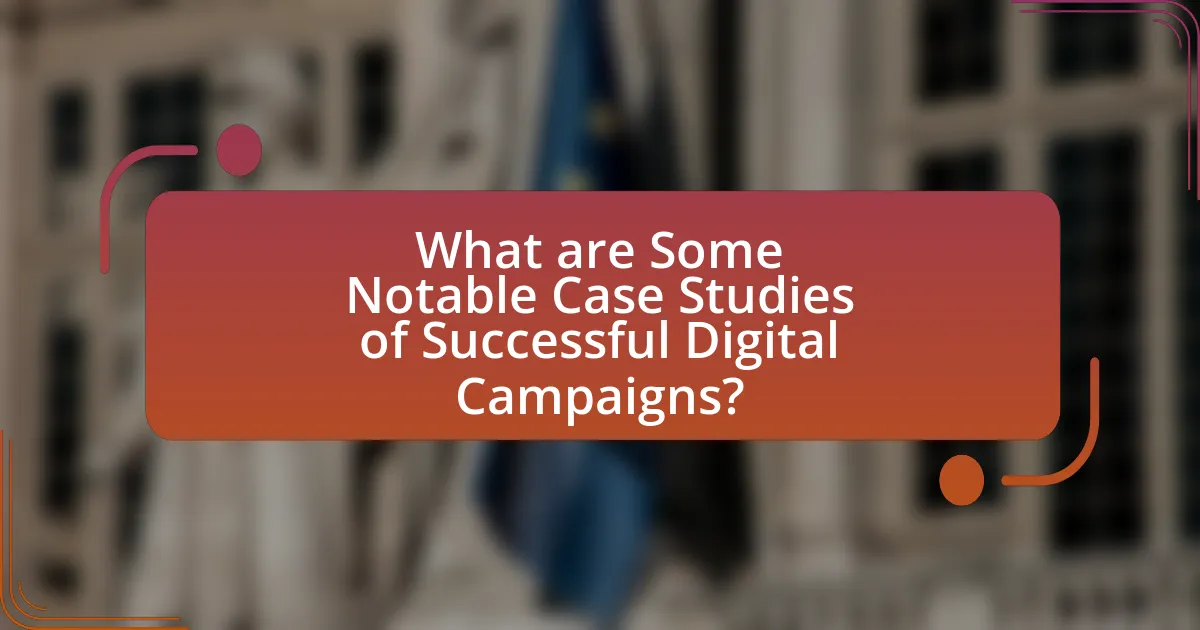
What are Some Notable Case Studies of Successful Digital Campaigns?
Notable case studies of successful digital campaigns include Barack Obama’s 2008 presidential campaign, which utilized social media and targeted online advertising to engage younger voters, resulting in a 66% turnout among voters aged 18-29. Another example is the 2016 Brexit campaign, where the Vote Leave group effectively used Facebook ads to reach undecided voters, contributing to a 52% vote in favor of leaving the EU. Additionally, the 2020 Biden campaign leveraged data analytics and digital outreach to mobilize voters during the COVID-19 pandemic, achieving record voter turnout with over 81 million votes. These campaigns demonstrate the power of digital strategies in influencing electoral outcomes.
Which recent elections featured successful digital campaigns?
The 2020 United States presidential election featured successful digital campaigns, particularly those of Joe Biden and Donald Trump. Joe Biden’s campaign effectively utilized social media platforms and targeted digital advertising to engage younger voters, resulting in a significant increase in voter turnout among this demographic. Additionally, the campaign raised over $200 million through online donations, showcasing the power of digital fundraising. Donald Trump’s campaign also leveraged digital strategies, focusing on rallying his base through targeted ads and social media engagement, which contributed to his strong performance in key battleground states. These examples illustrate the critical role of digital campaigns in shaping electoral outcomes in recent elections.
What strategies were employed in the 2020 U.S. Presidential Election?
The 2020 U.S. Presidential Election employed several key strategies, including extensive digital campaigning, targeted advertising, and grassroots mobilization. The Biden campaign utilized social media platforms like Facebook and Twitter to engage voters, while the Trump campaign focused on rallying support through direct messaging and targeted ads based on voter data analytics. Additionally, both campaigns adapted to the COVID-19 pandemic by emphasizing virtual events and mail-in voting, which significantly influenced voter turnout. According to the U.S. Census Bureau, approximately 159 million Americans voted in the election, representing the highest voter turnout rate for a presidential election in the U.S. since 1900, highlighting the effectiveness of these strategies.
How did the 2021 Canadian Federal Election utilize digital campaigning?
The 2021 Canadian Federal Election utilized digital campaigning through targeted social media advertising, online engagement strategies, and data analytics to reach voters effectively. Political parties, including the Liberal Party and the Conservative Party, invested heavily in platforms like Facebook, Instagram, and Twitter to disseminate their messages and mobilize support. For instance, the Liberal Party reportedly spent over $1 million on Facebook ads alone, focusing on key demographics and regions to maximize impact. Additionally, parties employed data-driven approaches to analyze voter behavior and preferences, allowing them to tailor their campaigns and messaging accordingly. This strategic use of digital tools contributed to higher voter engagement and participation compared to previous elections.
What lessons can be learned from these successful campaigns?
Successful campaigns demonstrate the importance of targeted messaging and audience engagement. These campaigns effectively utilized data analytics to identify key voter demographics, tailoring their messages to resonate with specific groups. For instance, the 2020 Biden campaign leveraged social media platforms to reach younger voters, resulting in a significant increase in voter turnout among that demographic. Additionally, successful campaigns often emphasize the need for authenticity and transparency, as seen in the Obama campaign’s use of personal storytelling to build trust with voters. These strategies highlight the critical role of understanding voter behavior and preferences in crafting effective digital outreach.
What common strategies contributed to their success?
Common strategies that contributed to the success of digital campaigns in recent elections include targeted advertising, data-driven decision-making, and effective use of social media platforms. Targeted advertising allows campaigns to reach specific demographics, increasing engagement and conversion rates. Data-driven decision-making enables campaigns to analyze voter behavior and preferences, optimizing messaging and outreach efforts. Effective use of social media platforms facilitates direct communication with voters, fostering community and mobilizing support. These strategies have been validated by numerous successful campaigns, such as Barack Obama’s 2008 election, which utilized targeted ads and social media to engage younger voters, resulting in a significant increase in voter turnout among that demographic.
How did these campaigns measure their effectiveness?
These campaigns measured their effectiveness through various metrics, including engagement rates, conversion rates, and return on investment (ROI). For instance, they analyzed social media interactions, such as likes, shares, and comments, to gauge audience engagement. Additionally, they tracked website traffic and the number of sign-ups or donations generated from specific digital ads to assess conversion rates. Campaigns also calculated ROI by comparing the costs of digital advertising to the financial contributions received, providing a clear picture of their overall impact.
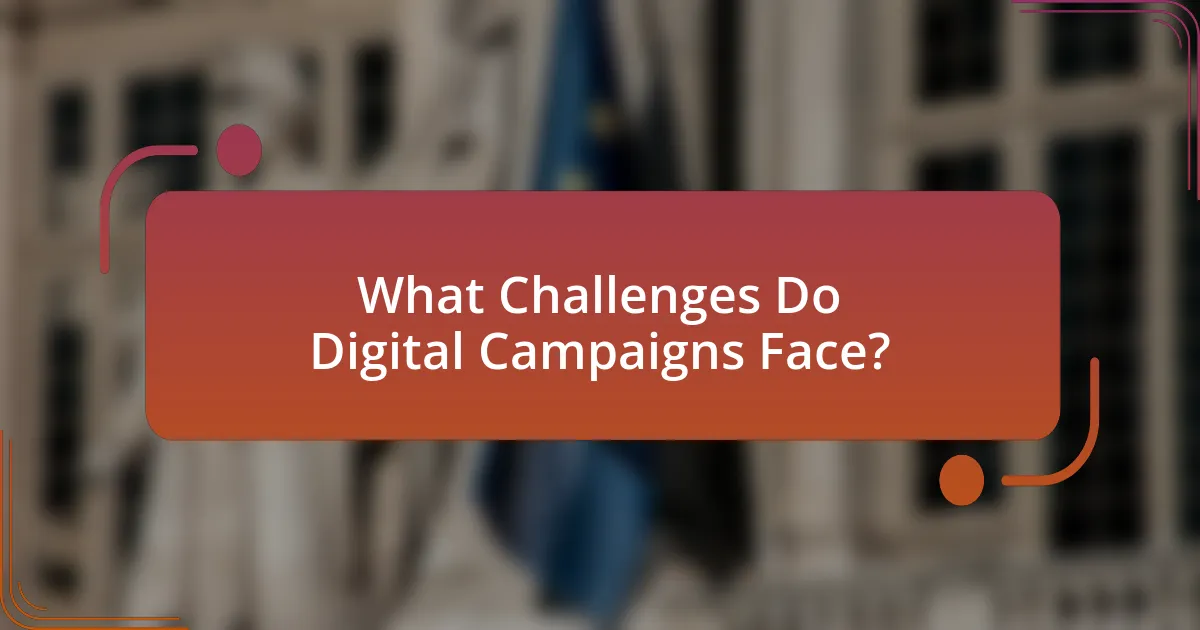
What Challenges Do Digital Campaigns Face?
Digital campaigns face several challenges, including audience fragmentation, ad fatigue, and data privacy concerns. Audience fragmentation occurs as consumers engage with multiple platforms, making it difficult for campaigns to reach a cohesive target demographic effectively. Ad fatigue arises when users are exposed to the same advertisements repeatedly, leading to decreased engagement and effectiveness. Data privacy concerns have intensified due to regulations like GDPR and CCPA, which restrict how campaigns can collect and utilize consumer data, complicating targeting strategies. These challenges can significantly impact the overall success and ROI of digital campaigns in elections.
What are the potential pitfalls of digital campaigning?
The potential pitfalls of digital campaigning include misinformation, data privacy concerns, and audience fragmentation. Misinformation can spread rapidly through social media, leading to public confusion and distrust; for instance, a study by the Pew Research Center found that 64% of Americans believe fabricated news stories cause confusion about the basic facts of current events. Data privacy concerns arise from the collection and use of personal information, which can lead to backlash if users feel their data is being exploited; the Cambridge Analytica scandal exemplifies this issue, where personal data was misused for political advertising. Audience fragmentation occurs when campaigns target niche groups, potentially alienating broader voter bases; research indicates that overly targeted messaging can create echo chambers, limiting the effectiveness of outreach efforts.
How can misinformation impact digital campaigns?
Misinformation can significantly undermine digital campaigns by eroding trust and distorting public perception. When false information spreads, it can lead to misinformed voter decisions, negatively affecting campaign outcomes. For instance, a study by the Pew Research Center found that 64% of Americans believe that misinformation has caused confusion about basic facts regarding political issues. This confusion can result in decreased engagement and support for candidates, as voters may become disillusioned or skeptical of campaign messages. Furthermore, misinformation can amplify polarization, making it harder for campaigns to reach undecided voters and fostering an environment where divisive narratives thrive.
What privacy concerns arise from digital campaigning?
Digital campaigning raises significant privacy concerns primarily related to data collection, user profiling, and targeted advertising. Campaigns often gather extensive personal information from social media platforms and online behavior, which can lead to unauthorized use of sensitive data. For instance, the Cambridge Analytica scandal highlighted how personal data from millions of Facebook users was harvested without consent for political advertising, demonstrating the risks of data misuse. Additionally, the lack of transparency in how data is used for targeting can erode public trust and violate privacy regulations, such as the General Data Protection Regulation (GDPR) in Europe, which mandates strict guidelines on data handling and user consent.
How can campaigns overcome these challenges?
Campaigns can overcome challenges by leveraging data analytics to target specific voter demographics effectively. By utilizing advanced analytics tools, campaigns can identify key voter segments and tailor their messaging to resonate with those groups, thereby increasing engagement and support. For instance, the 2020 Biden campaign utilized data-driven strategies to reach undecided voters through personalized digital ads, resulting in a significant increase in voter turnout. This approach demonstrates that targeted messaging, informed by data insights, can effectively address the challenges of voter engagement and mobilization in digital campaigns.
What best practices can be implemented to ensure success?
To ensure success in digital campaigns during elections, implementing targeted audience segmentation is essential. This practice allows campaigns to tailor messages to specific demographics, increasing engagement and conversion rates. For instance, the 2020 Biden campaign effectively utilized data analytics to segment voters by age, location, and interests, resulting in a more personalized outreach strategy that significantly boosted voter turnout. Additionally, leveraging social media platforms for real-time engagement and feedback has proven effective; campaigns that actively interact with constituents on platforms like Twitter and Facebook can adapt their strategies quickly based on public sentiment, as demonstrated by the successful use of social media by the Obama campaign in 2008.
How can campaigns effectively manage their online reputation?
Campaigns can effectively manage their online reputation by actively monitoring their digital presence, engaging with their audience, and addressing negative feedback promptly. Monitoring tools like Google Alerts and social media analytics allow campaigns to track mentions and sentiment, enabling them to respond quickly to any issues. Engaging with supporters through social media platforms fosters a positive community and builds trust. Additionally, addressing negative comments or misinformation transparently can mitigate potential damage to the campaign’s image. Research indicates that 70% of consumers are more likely to support brands that respond to their feedback, highlighting the importance of proactive reputation management.
What are the Future Trends in Digital Campaigning?
Future trends in digital campaigning include increased personalization through data analytics, the use of artificial intelligence for targeted messaging, and the rise of video content as a primary engagement tool. Personalization is driven by advancements in data analytics, allowing campaigns to tailor messages to individual preferences, which has been shown to improve engagement rates significantly. AI technologies enable campaigns to analyze vast amounts of data to optimize targeting and messaging strategies, enhancing effectiveness. Additionally, video content continues to dominate social media platforms, with studies indicating that video posts generate 1200% more shares than text and image content combined, making it a crucial element in future digital campaigns.
How will emerging technologies shape future digital campaigns?
Emerging technologies will significantly shape future digital campaigns by enhancing targeting precision, improving engagement through interactive content, and leveraging data analytics for real-time decision-making. For instance, advancements in artificial intelligence and machine learning enable marketers to analyze consumer behavior patterns more effectively, allowing for personalized messaging that resonates with specific audience segments. According to a report by McKinsey, companies that utilize advanced analytics in their marketing strategies can achieve a 15-20% increase in marketing effectiveness. Additionally, technologies like augmented reality and virtual reality can create immersive experiences that captivate users, as seen in successful campaigns such as the 2020 U.S. presidential election, where AR was used to engage younger voters. These technologies not only optimize campaign performance but also foster deeper connections between brands and consumers.
What role will data analytics play in upcoming elections?
Data analytics will play a crucial role in upcoming elections by enabling campaigns to target voters more effectively and optimize their strategies. Campaigns will utilize data analytics to analyze voter demographics, preferences, and behaviors, allowing them to tailor messages and outreach efforts. For instance, the 2020 U.S. presidential election saw campaigns leveraging data analytics to identify swing states and key voter segments, resulting in more focused advertising and engagement strategies. This approach has been shown to increase voter turnout and support, as evidenced by the significant impact of targeted digital ads on voter mobilization efforts.
What Practical Tips Can Campaigns Use for Successful Digital Strategies?
Campaigns can enhance their digital strategies by focusing on targeted audience segmentation, utilizing data analytics, and engaging through multiple platforms. Targeted audience segmentation allows campaigns to tailor messages to specific demographics, increasing relevance and engagement. Data analytics provides insights into voter behavior and preferences, enabling campaigns to optimize their messaging and outreach efforts. Engaging through multiple platforms, such as social media, email, and websites, ensures broader reach and interaction, as evidenced by the 2020 U.S. elections where campaigns that effectively utilized social media saw higher engagement rates and voter turnout.



